September 20 - 26, 2015: Issue 232
Spring Equinox 2015: A Wonderful Time to Walk Among Australia’s Bush Flowers
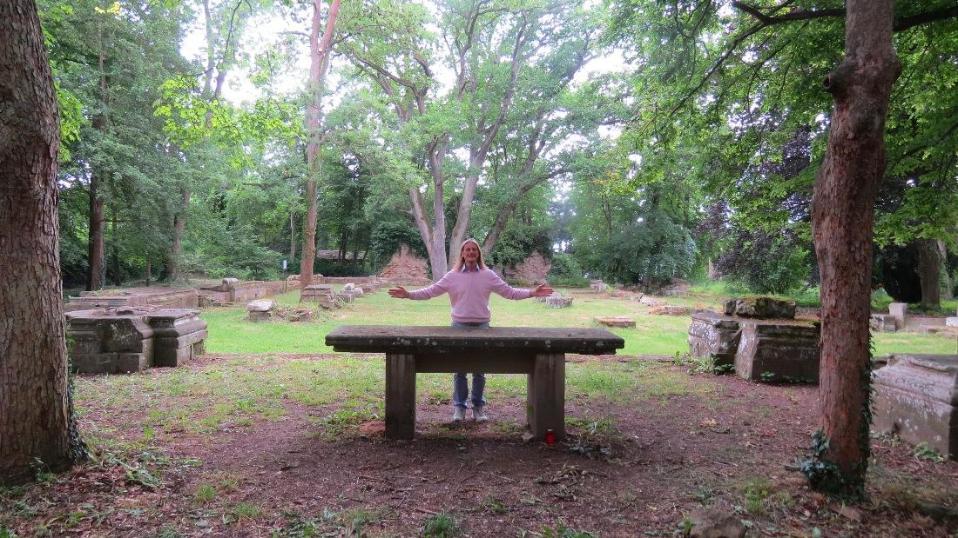
Ian at Hildegard's Altar in old Monastery
The Vernal (Spring) Equinox in Australia is on Wednesday, 23 September 2015 at 5:52 PM ACST. Spring, being a time of renewal, growth and healing, filled with positive energy, it is clearly one of the best times of the year to revel in all going on outdoors.
As shown by recent pictures shared by readers, the Australian bush is alive with flowers unique to our continent at present. You feel great just being in these places at this time of the year, the perfume through the air, the millions of colourful plants draw your eyes to see the pink flush of Boronia, or that yellow blaze of bush peas. It makes a bushwalk a healing practice in itself – you feel good after a stroll beneath our wonderful trees at this annual rise of light.
It is a time we think of the Australian Bush Flower Essences and wonder about how and when the connection between how good we feel and how beneficial these flowers, as Essences, first came about as new knowledge.
Quite recently Ian White, Founder of Australian Bush Flower Essences (ABFE) mentioned his Winter 2015 visit to the monastery of Hildegard von Bingen, a German Benedictine abbess, writer, composer, philosopher, Christian mystic, visionary, and polymath, who is known for having used flowers for promoting good health and healing. We spoke to Ian about this visit:
PON: You have recently visited the ruins of a monastery where Hildegard von Bingen, the first European to have used flowers for healing once lived?
IW: Yes, she was the first recorded European to have used Flower Essences. I’m sure there were probably European people who used them before that. The Egyptians, for example, used Flower Essences for healing three thousand years ago.
Hildegard was born in 1098 and became an Abbess of the Disibodenberg monastery and was officially classified as a prophet by the Catholic Church during her life.
One of Pope Benedict’s last actions before he resigned in 2013 was to make her a Saint of the Catholic Church, a process which started about 30 years after she passed away in 1179 – so not a process for those with a lack of patience.
Hildegard wrote how gold light would come into her forehead, what we would now call the ‘third eye’, bringing her messages. Hildegard received a great deal of information on the qualities of many flowers for the healing of different ailments and emotional states. The nuns would lay sheets of muslin out over the flowers at night to absorb the dew of the flower. In the morning they would collect these muslin sheets, wring them out and give the dew to those people who needed whatever emotional or physical problems the flower dew could help with.
PON: Where was her abbey?
IW: It was very close to the Rhine River in an area called Disibodenberg, in Southern Germany, about 100ks from Frankfurt. Hildegard was there for 30 years.
PON: What flowers would have or do grow there?
IW: Very common European flowering ones, in Springtime it’s a mass of blooms right along the banks, many of these being white and blue in colour*. In Australia we have a predominance of red and purple flowers. In colour therapy red represents vitality while purple is for spirituality.
PON: What are the grounds at Disibodenberg like?
IW: They’re incredibly peaceful even though they are only ruins. After being there for 30 years she moved her monastery to Bingen, where there is only a cellar left. The Swedes did a lot of invading of Europe during the 16th century and destroyed her original monastery at Disibodenberg. It is still available to go to and walk around and you can see the structures of some of these original buildings even though they have deteriorated. It’s a very peaceful and calming place.
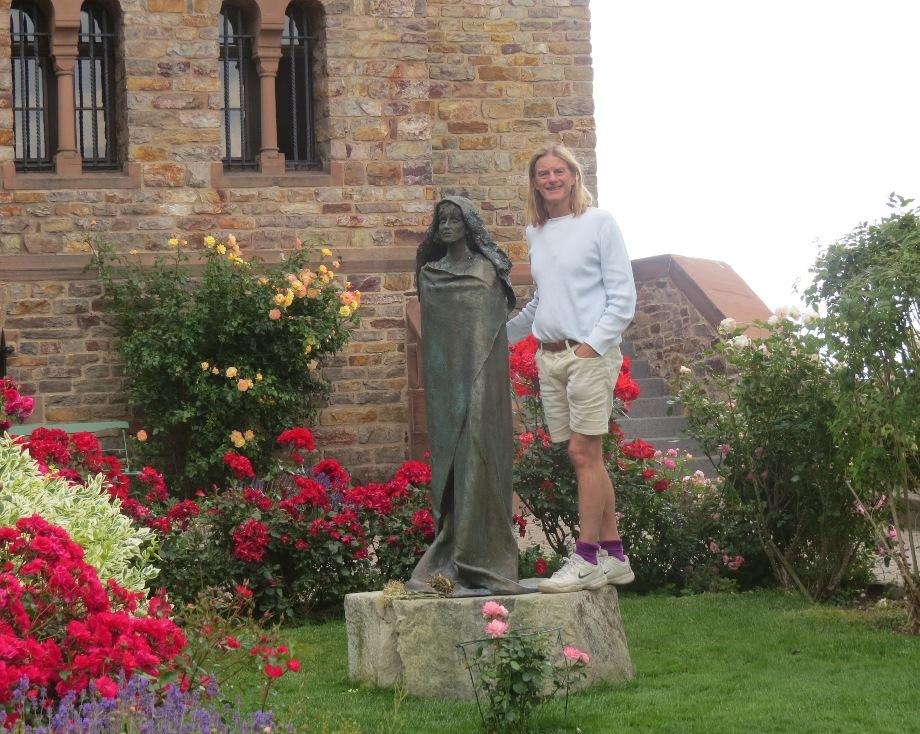
Ian with Hildegard's statue at Eibingen Abbey (in German Abtei St. Hildegard, full name Benedictine Abbey of St. Hildegard) near Rüdesheim in Hesse, Germany.
While we were visiting I met one group of people who had travelled a couple of hundred kilometres across Germany to go there. Among this group was a German man, who a bit cautiously said ‘can you feel how peaceful and wonderful it is here?’
People go there for the energy of what was there in the past and this does feel like a very high energy, and it’s still very potent.
When I’m making my Bush Essences I can feel the presence of Hildegard around me and when visiting her ruins recently I had a very strong sense to pick up a couple of the small stones where the original altar was, and to lay these stones next to the bowls when I am preparing Essences here in Australia. It feels like a nice connection or sense of continuance to someone who worked with Flower Essences such a long time ago.
PON: Spring in Australia is a time when we see many more flowers than those that bloom through every other season here – what flowers are currently out in our bush?
IW: If you look at just the Pittwater region our spring starts around July when Slender Rice flower begins to appear along with Boronia ledifolia and Red Grevillia, then it’s a procession of others. In fact, because it has been quite a mild winter, the Sydney Rose for example, which is not a rose but a member of the Boronia family, was weeks earlier flowering than in most years.
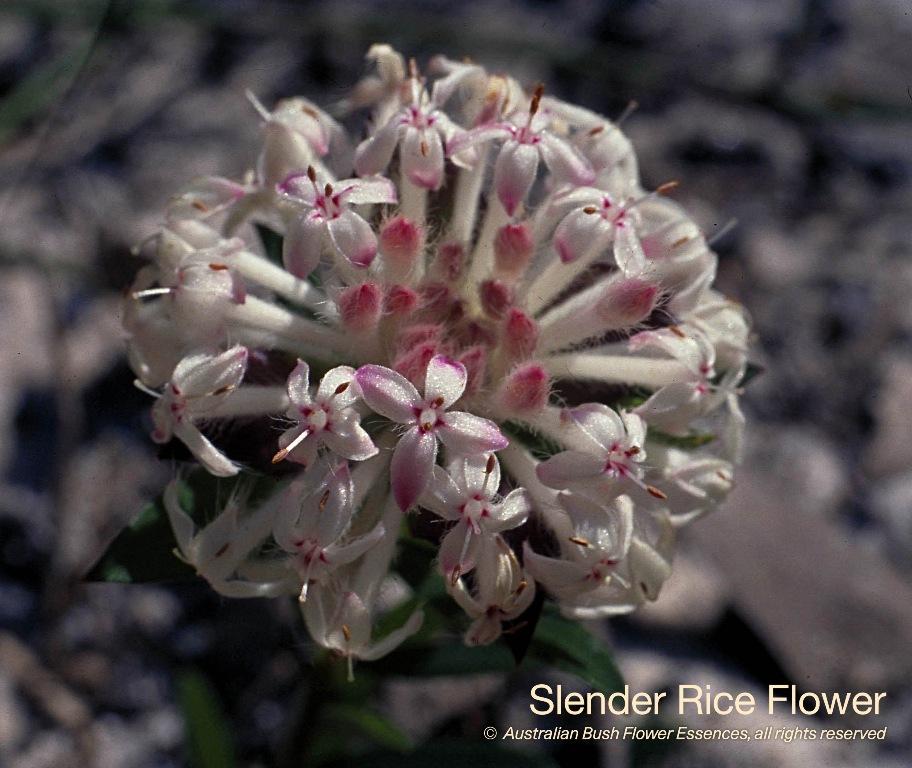
Now we’re starting to see flowers such as Isopogon with its lovely yellow flower, Five Corners are out in buds and getting close to bursting through, Grey Spider Flower is out, as are Flannel Flower and Little Flannel Flower, in fact it’s a great time to be walking in the bush at this time of the year as every couple of weeks the plants out in flower really change, with new flowers all coming out.
PON: These verges of Spring and their flowerings, have you noticed a correspondence between what blooms when and what people or animals may need at each part of each Season, similar to what we find with food, where foods that the body may need at the end of Winter, such as high Vitamin C fruits, oranges, or vegetables such as artichoke with the most antioxidant of all, as examples, then crop?
IW: Certainly I think that every time there is a need in human society Essences will come down to meet that need. One of the things I like is that Dagger Hakea, which flowers at Christmas time, a time when families are getting together for perhaps the first or second time for the whole year, and some of the unresolved issues between the various members can come to the fore, can help with healing these rifts. So it is a perfect time for this flower to bloom. If you walk through the bush at Christmas, when the Dagger Hakea is out, it’s usually warm weather, and there’s this rich, sweet honey cinnamon scent all through the bush.
PON: You make Essences of these spring flowering Bush Flowers named – how do they benefit people, what conditions can they alleviate?
IW: There is a correlation that has been noticed for thousands of years between physical symptoms and the emotions. Once you treat the emotions you get this nice flow on effect of preventing other problems. Holding on to resentment for example, will lead to problems with the liver. Five Corners, which is now starting to flower, is a wonderful remedy for self-esteem and I’m sure there aren’t any among your readers who haven’t had a period in life where they felt like they could use a little boost in that area.
PON: Yes, some of us will be doing HSC exams soon or looking for a new swimming costume and venturing one toe into the water again after too many mashed potatoes over winter. What else?
IW: Bush Fuchsia is an incredibly effective remedy to enhance all learning skills and abilities, a fantastic remedy for everyone doing study or exams. It is also boosts co-ordination, so for anyone taking up tennis again now the weather is getting warmer it will help their eye-hand co-ordination, it will even help one’s dancing skills – get rid of the having 2 left legs syndrome! Slender Rice Flower deals very much with group harmony and xenophobia, and during a time when we’re talking of taking in more refugees this is a perfect one for that sense of group harmony and that ‘no one is better than anyone else’ perspective.
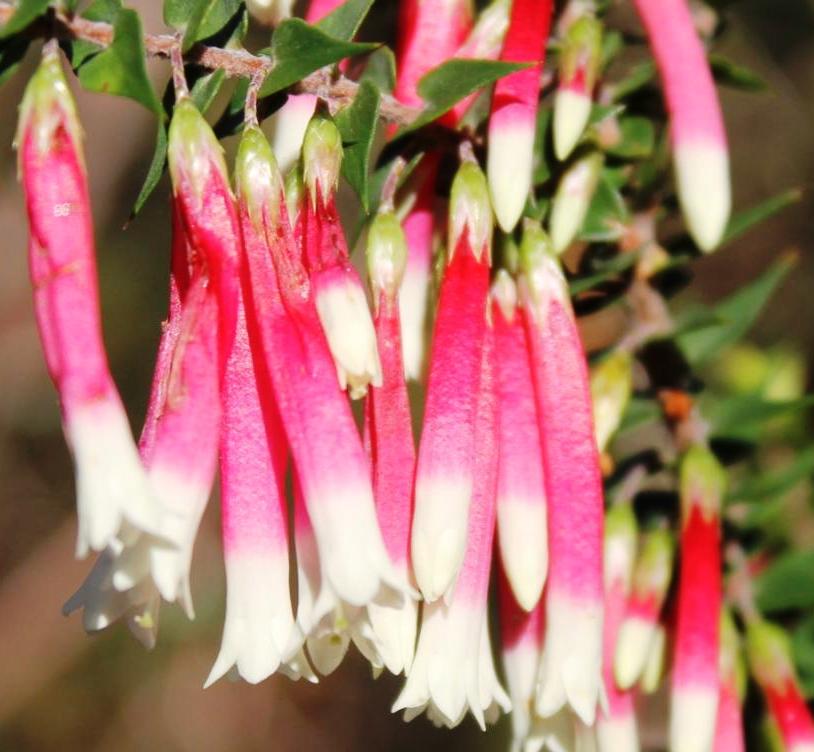
Epacris longiflora - Bush Fuschia
PON: And perhaps good for emerging from winter hibernation into spring and summer sunshine and meeting people?
IW: Yes, absolutely. There is one plant called Sunshine Wattle, an Autumn flowering one, so as we’re about to go into Winter it’s a nice one to keep that energy and oomph and also the sun has quite a powerful healing effect which works on the pineal gland and taking in light, which regulates our body clock. This is a good one to take when people are feeling a bit down when there’s a lot of darkness around during the long winter nights and short winter days (or perhaps when people feel that end of Summer/Autumn Winter slight melancholy that tinges those parts of these seasonal flows.) Conversely you can use Black-eyed Susan to the combat the rushing around and being overly busy that can occur when there are longer days with a great deal more light present. It is the remedy for Type A people, always doing lots and pushing themselves or those who are very impatient.
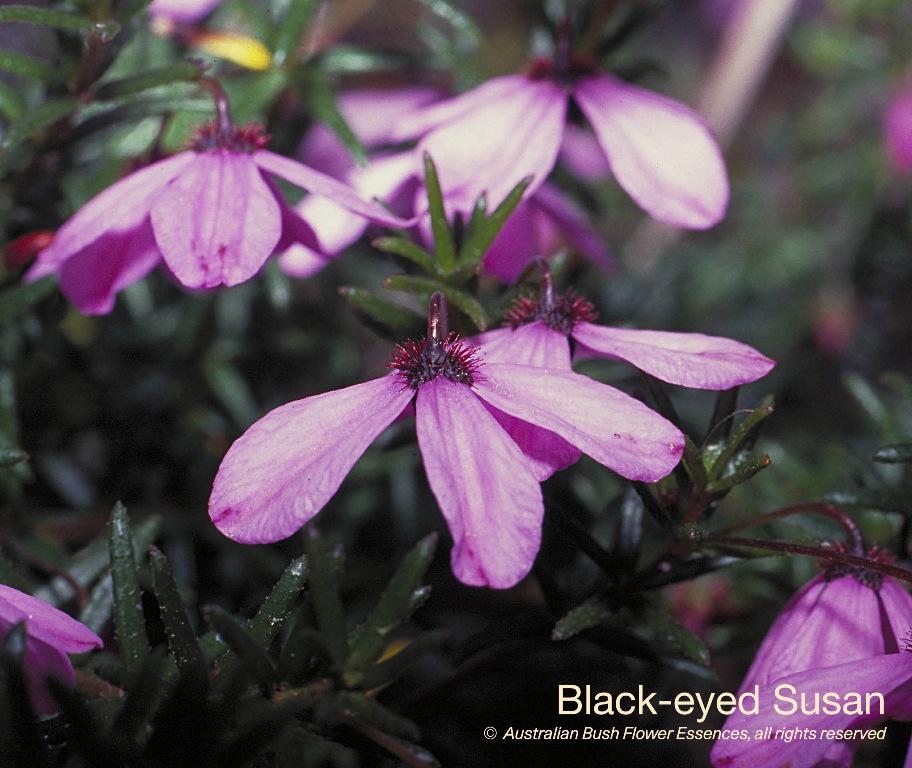
PON: The Spring Equinox falls on September 23rd this year – does this day hold any special significance for you?
IW: Both the Equinoxes and Solstices are times I spend a little more time in reflection and I find my intuition and inner guidance is heightened during these times. In another way the days are getting longer with more light and warmer weather, so that’s always nice and something to look forward to. It’s also the peak flowering time and here in Pittwater that would probably be that last week in August right through until about the second week in October. This is a great time to be out in the bush if you’re not feeling good or even in fact just walking through the bush now you pick up all the healing energies of the plants and you will feel a lot better– you have the colours, the potency, the scent – the Boronia we mentioned is flourishing this year – you can crush a gum leaf and get that scent or just being out in the rich pungent scent of the Pittwater bush, immersing yourself in it, is going to make you feel good. Of course making an Essence of that flower concentrates that healing energy even further.
PON: How does it feel to be bringing forward, continuing and adding to the range of Flower Essence knowledge at such a high level?
IW: Probably the modern rediscoverer of Flower Essences and their healing properties was an English doctor by the name of Edward Bach, so I’m after him. Sometimes when I’m teaching Workshops I do get a sense of people such as Bach and Hildegard von Bingen being present. The goal is to bring about healing in a very safe and simple way. There is so much untapped healing potential in these Essences that we all have at our disposal.
The Flower Essences is a modality that is very simple because it is working on emotional states. You don’t have to be trained for seven years in medicine or four years in Naturopathy or Acupuncture to recognise when you have a child who is a bit shy or fearful, or is feeling rejected because they were not invited to the birthday party that their other friends were and don’t want to go to school and are upset. You can choose and prescribe the Essences to help with this and know you’re not going to create any harm.
Another example would be if a family pet has died and it’s the first time a child has come in contact with death. A young child can sometimes feel when they first experience loss that mum and dad may die too and they become more uncertain of the world, so there are Essences which deal with fear of death (Bush Iris ), grief and sadness ( Sturt Desert Pea ) which can help deal with these issues.
PON: So it feels good to be bringing forward this knowledge?
IW: Absolutely and that certainly motivates my goal to be able to make the Bush Essences to be better known and available to more and more people. Just today I received an email from a lady in Noosa who has recently lost her husband unexpectedly and suddenly and has been feeling very sad and naturally had to deal with the shock that came along with all those emotions. She felt she wasn’t in the right space to choose what Essences she knew would help her and so sent an email and I was able to tell her of what would help. I also get tremendous satisfaction when receiving emails or testimonials from people who have had great benefit - frequently life changing, or help when either they or their patients have taken the Bush Essences.
There are Essences that will work in all various situations, from when your football team doesn’t do so well for example, or people being worried about the economy or their job or their children. For all the basic emotions; fear, anger, grief, worry – there’s Essences.
PON: How can people learn more about the Australian Bush Flower Essences?
IW: We have many teachers offering a range of courses from introductory to more in depth weekend courses. I am running many courses online, people can also do our Distant Education Course if they cannot attend a workshop and as well we have many of our courses available on DVD. We have a Level 3 Workshop coming up on the long weekend in October, which is for people who have attended a Level 1, or done the Introductory Course available, which will give them the basics on the flowers and how they work. The Level 3 Workshop runs over three days and also includes making an Essence as a group and incorporates a lot of time being out in the bush and seeing may of the plants I make essences from. This year we have a group from France attending as well as people from Latvia and Asia among the Australian people who will be doing this Level 3 Workshop.
PON: I noticed there will be a White Light Essence workshop beginning in October too – which I attended several years ago and found to be a wonderful experience – what are the White Light Essences for those who have not encountered them before – they’re different from the Flower Essences aren’t they?
IW: Yes. These are 7 remedies made at high energy centres from around the world including Katajuta and also Heron Island here in Australia. The others were made in Europe, South America and one in a sacred cave in Northern India, near the Tibetan border. These remedies are working more at a soul or spiritual level and also deepening our connection with the Elements; Earth, Air, Fire, Water. Each element also corresponds to a different seasons and personality type. There are group meditations on each of the seven Essences during the workshop I also share case histories about each Essence, along with their full healing qualities and how to prescribe them.
PON: What flower are you visualizing right now Ian?!!!!!
IW: (laughs) Well, in looking at your bright red jumper I’m reminded of Waratah, which is also coming out in bud at present.
The waratah is a wonderful flower, it’s Latin name ‘telepoa’ means ‘seen from afar’ and this is what you experience when you come across them out in the bush, you can spot this magnificent bright red flowering plant from a long way away, it stops you in your tracks.
The waratah was the highest flower for the aboriginals and the only flower they ever gave to the white settlers. It was recorded in the diary of the doctor of the First Fleet that when aboriginal people were sick they would float waratahs in water then drink the water to heal themselves.
It should have been the floral emblem for Australia and it was only the fact that it didn’t grow in all States was the reason that the ubiquitous wattle was chosen instead. I think it remains the flower that most Australians identify with as uniquely Australian and remains one of the most powerful healing Flower Essences as well. It can be used for anyone going through a “black night of the soul” and in utter despair. It will give them the strength and courage to cope with their crisis. It is for emergencies and great challenges and importantly is very powerful and quick acting.
______________________________
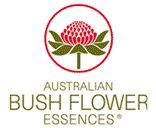 Australian Bush Flower Essences - Upcoming Workshops
Australian Bush Flower Essences - Upcoming Workshops
Level 3 - 3 to 5 October - Lecturer: Ian White
White Light Essences - 10 & 11 October - Lecturer: Ian White
For Bookings or queries: Uschi Wilmer Email: uschi@ausflowers.com.au Ph: 02 9450 1388
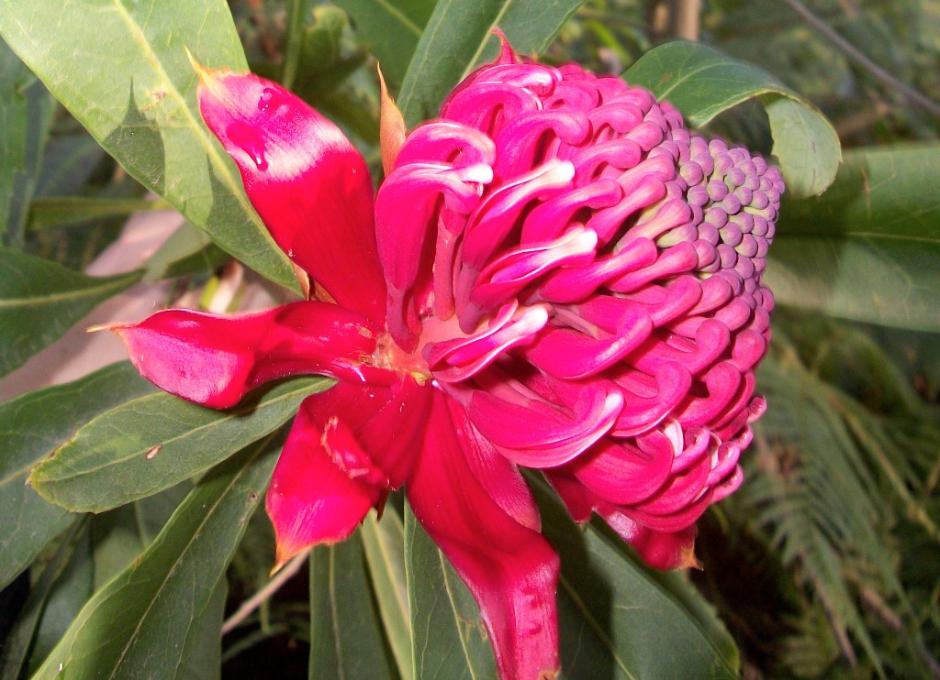
Waratah - in Pittwater - photo by A J Guesdon.
* Flowers that Bloom where Hildgard was are: all white/purple/blue. Some of the healing herbs, flowers, and foodstuffs mentioned by the twelfth-century Benedictine abbess Hildegard of Bingen in her great work Physica are: Field peas (Pisum sativum arvense); Madonna lily (Lilium candidum); milk thistle (Silybum marianum).
It (Physica )is the first book in which a woman discusses plants and trees in relation to their physical properties. It is the earliest book on natural history to be done in Germany and is, in essence, the foundation of botanical study there. It influenced the 16th-century works of Brunfels, Fuchs, and Bock, the so-called “German fathers of botany,” but the fact is that German botany is more indebted to a “mother.” —Frank Anderson on the Physica, from An Illustrated History of the Herbals
Equinox the time when the sun crosses the plane of the earth's equator,making night and day of approximately equal length all over the earth. From 1350-1400; Middle English < Medieval Latin equinoxium, for Latinaequinoctium the time of equal days and nights ( aequi- equi- + noct- (stem of nox) night + -ium -ium )
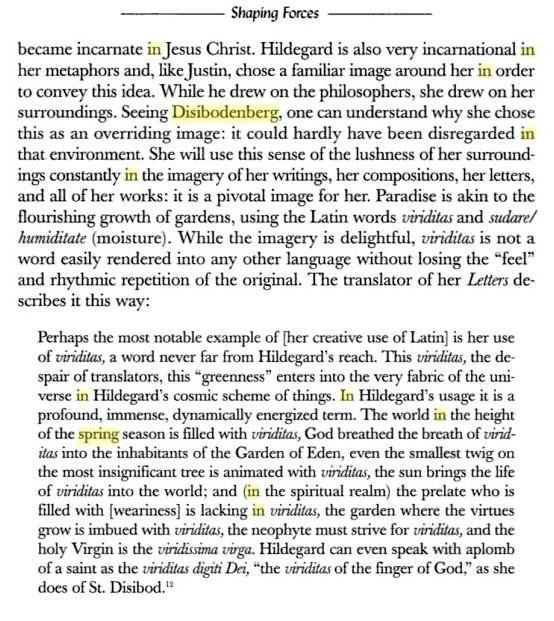
Immune system may be pathway between nature and good health
September 16, 2015 - Research has found evidence that spending time in nature provides protections against a startling range of diseases, including depression, diabetes, obesity, ADHD, cardiovascular disease, cancer, and many more. How this exposure to green space leads to better health has remained a mystery. After reviewing hundreds of studies examining nature's effects on health, University of Illinois environment and behavior researcher Ming Kuo believes the answer lies in nature's ability to enhance the functioning of the body's immune system.
"I pulled every bit of the research in this area together that I could find, and was surprised to realize I could trace as many as 21 possible pathways between nature and good health--and even more surprised to realize that all but two of the pathways shared a single common denominator," Kuo said. She said it was remarkable to see how important a role the immune system plays in every one of the diseases that nature protects against.
"The realization that there are so many pathways helps explain not only how nature promotes health, but also why nature has such huge, broad effects on health," she said. "Nature doesn't just have one or two active ingredients. It's more like a multivitamin that provides us with all sorts of the nutrients we need. That's how nature can protect us from all these different kinds of diseases--cardiovascular, respiratory, mental health, musculoskeletal, etc. -- simultaneously."
One way to understand this relationship between nature, health, and the immune system, Kuo explains, is that exposure to nature switches the body into "rest and digest" mode, which is the opposite of the "fight or flight" mode. When the body is in "fight or flight" mode, it shuts down everything that is immediately nonessential, including the immune system.
"When we feel completely safe, our body devotes resources to long-term investments that lead to good health outcomes--growing, reproducing, and building the immune system," Kuo said. "When we are in nature in that relaxed state, and our body knows that it's safe, it invests resources toward the immune system."
For those who prefer playing a board game or visiting an art gallery to taking a walk in the park, Kuo says some of the same restorative benefits can be obtained. "if you are absorbed and relaxed, chances are your parasympathetic system is happy and your immune system is going to get a boost. That said, these enjoyable indoor activities don't provide the phytoncides, mycobacterium vaccae, negative air ions, vitamin D-producing sunlight, and other active ingredients found outdoors. So we'd expect a smaller boost than you'd get from being in nature."
Kuo is the director of the Landscape and Human Health Laboratory at the U of I and has conducted numerous studies of her own linking green space and health. Kuo hopes her exhaustive compilation of studies will provide a map for what researchers in this field might study next.
"Finding that the immune system is a primary pathway provides an answer to the question of 'how' nature and the body work in concert to fight disease," Kuo said.
"How might contact with nature promote human health? Exploring promising mechanisms and a possible central pathway" is published in Frontiers in Psychology and available online.
Ming Kuo. How might contact with nature promote human health? Promising mechanisms and a possible central pathway. Frontiers in Psychology, 2015; 6 DOI: 10.3389/fpsyg.2015.01093Ming Kuo.
__________________________